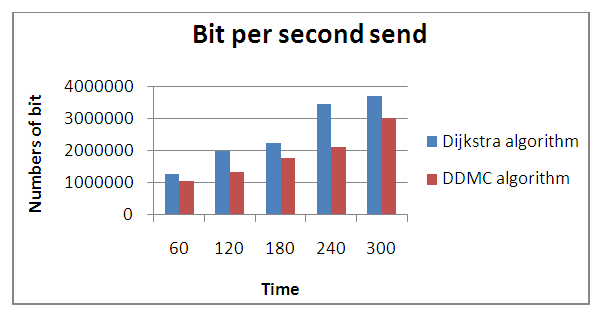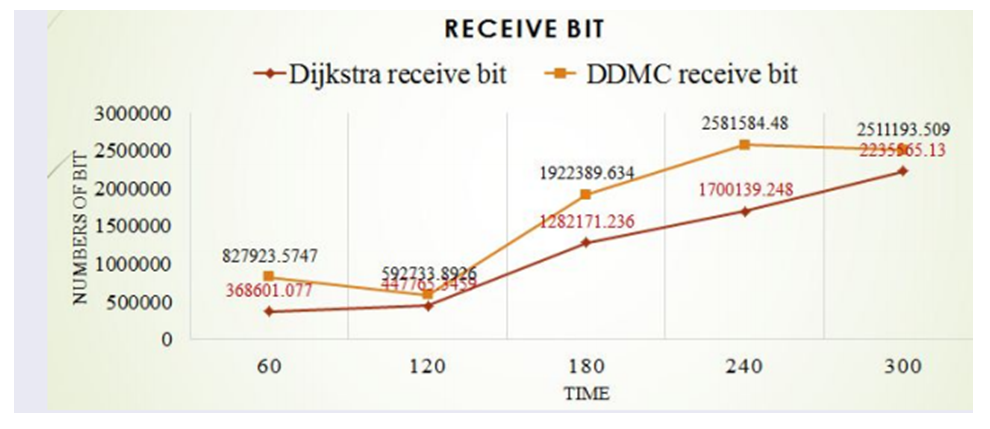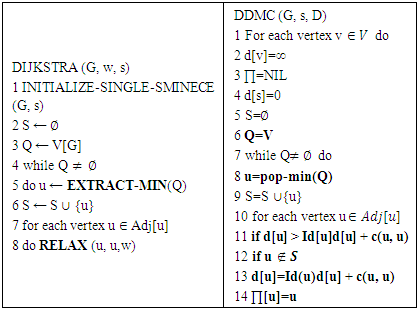-
Paper Information
- Paper Submission
-
Journal Information
- About This Journal
- Editorial Board
- Current Issue
- Archive
- Author Guidelines
- Contact Us
International Journal of Networks and Communications
p-ISSN: 2168-4936 e-ISSN: 2168-4944
2020; 10(2): 41-46
doi:10.5923/j.ijnc.20201002.02
Received: Sep. 22, 2020; Accepted: Oct. 13, 2020; Published: Oct. 26, 2020

Comparison of DDMC and Dijkstra Algorism on Topology Management in Large Publish-Subscribe Paradigm
Cheru Haile1, Shaik Janbhasha2, Solomon Aregawi3
1Department of Information Technology, Assosa University, Assosa, Ethiopia
2Department of Computer Science, Assosa University, Assosa, Ethiopia
3Department of Information Technology, Adigrat University, Adi Grat, Ethiopia
Correspondence to: Cheru Haile, Department of Information Technology, Assosa University, Assosa, Ethiopia.
| Email: |  |
Copyright © 2020 The Author(s). Published by Scientific & Academic Publishing.
This work is licensed under the Creative Commons Attribution International License (CC BY).
http://creativecommons.org/licenses/by/4.0/

Now a day the architecture of internet has a problem for information route based on receiver interested in without knowing the sender and receiver address. Due to this reason new paradigm was introduced that is Publish-Subscribe. In Publish-Subscribe the receiver and sender do not expect to be active at the same time, do not know the address of each other, and do not use any blocking mechanism or client send request and server replay response. First the Publish-Subscribe network is built and designs enough the model then conduct implementation and evaluation of Publish-Subscribe network via destination driven multicast routing algorithm (DDMC) for selecting the shortest path in the network. Basically, the networks have Router to perform routing mechanism. The publisher is the producer of information. And the subscriber is the consumer of information with their own deferent type of module for facilitating their function. Every connection in the network is bidirectional way of communication (an undirected graph) with random seed available in the network. Each Router has topology management module for creating a picture of the networks and computing the available path. It informs to the forwarder in order to send the information of network for intended receiver. Record table module used for recording of the network information comes from the subscriber or the publisher via link state advertisement then it informs to the topology manager. Lastly, the comparison performance of Dijkstra algorithm with destination driven multicast routing algorithm (DDMC) in the large numbers of clients participated evaluate via total bits per second minimize 2.7% from the total bit and average delivery ratio DDMC was 87.1% but Dijkstra was 71.3%. So performance of destination driven multicast routing algorithm (DDMC) algorithm was good rather than Dijkstra algorithm.
Keywords: Publish-Subscribe, DDMC, Dijkstra, Topology management
Cite this paper: Cheru Haile, Shaik Janbhasha, Solomon Aregawi, Comparison of DDMC and Dijkstra Algorism on Topology Management in Large Publish-Subscribe Paradigm, International Journal of Networks and Communications, Vol. 10 No. 2, 2020, pp. 41-46. doi: 10.5923/j.ijnc.20201002.02.
Article Outline
1. Introduction
- In the client/server announcement paradigm, the client sends a request to the server and the server response to the client request. The client is fruitless until it received response from the server. Which means the communication was based on request/respond paradigm, as well as the communication, was coupled. The above communication is an old type or the traditional communication way where the senders have to know receivers address (destination address). This type of communication is known as couple communication. However, this types of communication can be substituted by Publish-Subscribe paradigm [1]. Based on the PSIRP architecture [2] the IP based communication can be substituted via Publish-Subscribe paradigm with users interested in subscription mechanism.Later this idea leads to the decouple communication based on Publish-Subscribe service (the sender and the receiver do not expect to know the address and vice versa (space decoupling), do not activate at the same time (time decoupling) and the information follows from producer to consumer also mediate (synchronization decoupling)) those are motivating characteristics of Publish-Subscribe systems [3]-[4].According to the PSIRP [5]-[6], the current internet architecture have a problem-related to IP based model. The first one is the coupling between the host location and identification, which is the IP semantic overload problem. Basically, host identification is based on his location, so that is the data it holds. For example, if it is a web-server. If there is a mobility event, then the host’s identification changes as its location point also change, breaking any ongoing communication channels. The problem here can’t express their interest in some content, just to query some location that if some data is a host-based approach, the content of the data cannot address and users cannot express their interest in data. For example the TCP/IP reference model [7] has four basic layer and all layers have their own specific function and its communication way is handled using of IP as well as endpoint-to-endpoint coupling connectivity, so in this case, it does not consider the user interest expression ways to the data. Developing selective notification Middleware that use to implement content based subscription system [8] which is used just like emergency service in smart cities. Developing mobile application using MQTT protocol with publish subscribe broker to efficient data dissemination methods with compressed data in smartphone via shared dictionary compression mechanism [9].Design a system use named data network for selecting and subscribe method to match and fetch address on publish subscribe [10]. According to [11] use dynamic destination based routing algorithm with MERC to improve scalability on publish subscribe based on cluster and content based mechanism on the PADRES system. In wireless sensor network scalability and reliability is the basic issue but [12] use virtual broker for communication to improve scalability and reliability in large scale of publish subscribe. Now a day, most of the Publish-Subscribe is used for fixed internet access as well as wireless device communication support. To the best of our knowledge mobility of the clients, topology management of the entire system as well as handoff or handover (roaming) processes are an open research area for modeling of the communication that support future of internet architecture. Based on this idea it focuses on performance comparison via awareness of the link that comes from the nearest node around the intended device in a Publish-Subscribe system based on destination driven routing algorithm for selecting the shortest path in the network and lastly compare this algorithm with Dijkstra algorithm.
2. Problem of Statement
- The Publish-Subscribe architecture of the new information follows in the network is based on user interest information delivery [13] and [14]. But it doesn’t initiate IP address based network connectivity to the desired receiver node. The subscriber first sends subscription information to the nearest Router about their interested information via registration mechanism. The Router is responsible for store and matching of information. Then users can get the information based on their subscription interested in. Most of the time routing of information in the cellular network is whether broadcast (one-to-all) (like “spanning tree algorithm”) send to all users, or unicast (“Dijkstra shortest path algorithm”) one-to-one communication. However, those communications do not consider the new sharing of internet information mechanism of Publish-Subscribe system. Current internet traffic follows data-oriented delivery system to the endpoint via IP address of the receiver. However, in the study [15] information must be published and it will be delivered to the interested subscribers of information through Publish-Subscribe internet paradigm. It can handle the problem of broadcast issues for the new information communication paradigm. Most of the studies [13] [14] have the idea of topology management in the large interconnected network device and the routing of the information in the network delivery mechanism. However, in multi-path of routing topology, there is an issue in selecting the best route in the topology. These studies, for instance [13] follow broadcast communication to form topology which has an impact on the performance of Publish-Subscribe network in terms of packet delivery ratio, delay, throughput, and high overhead. On the other hand, [14] used unicast communication strategy that also has an impact on the network performance with a high overhead issue. These problems drive us to propose topology management in large Publish-Subscribe paradigm with multicast communication strategy to compute and select shortest path to route information in Publish-Subscribe networks.
3. Related Works
- In the new network, architecture information will be routed based on the receiver interested in via Publish-Subscribe mechanisms. According to [13] an exchange of data in the form of Publish-Subscribe communication evaluation takes place by the idea of PURSUIT project. It deals with hierarchal naming structure with topology management in the network. The main difference of this article with our study is - The proposed prototype use multicast strategy rather than broadcast strategy.- The proposed prototype deal on the partial or cyclic graph forming topology in a large number of publisher and subscriber via randomly generated a numbers of nodes rather than hierarchal naming structure.In the intra-domain topology management [14] investigate the entire performance of local area network for the topology management was evaluated via the idea of PSIRP (Publish-Subscribe Internet Routing Protocol) project. The main difference between intra-domain and inter-domain is related to an administrative domain. Intra-domain is specified to the specific of the node within the domain but inter-domain is based on the entire administrative domain level. The main aim of PSIRP [5]-[6] was to redesign of the current internet architecture to the form of Publish-Subscribe communication patterns. The basic difference with proposed system, destination driven routing use (for multicasting information) rather than Dijkstra (for unicast information) for computing shortest path in the network as well as the study use the partial and cyclic network in the system with boots library. Mobility-aware of the Publish-Subscribe paradigm [17] used a prediction of client mobility in the topology of Publish-Subscribe network. It builds based on the idea of PURSUIT architecture on the WiMAX different position available of a base station that is stationary but the mobile had the ability to move from one base station to other via different reason.The main difference this paper with study, use router instead of base station and multicast (one-to-many or many-to-many) instead of Bi-casting (the base station can send two signal at a time).Based on the [18] there are numbers of constraint available in Publish-Subscribe communication system but the basic is two. a. Platform related constraint: related to computing platform restriction mobility enable in the system. The restrictions are: - Software constraint: support of mobility using the software deployment is difficult.- Hardware constraint: support mobility using hardware device development not efficient. Example battery capacity of sensor node and mobile.- Interaction constraint: the hardware interacts with the other device and modality.b. Network related constraint: which is basically focused on the wireless network and also on the wired network. It may be:- Performance constraint: when comparing the delay and throughput it is high in the wireless network with a wired network.- Topological constraint: forming, maintaining, dynamically reconfiguration of the broker and client during disconnected/re-subscription to the topology is not efficient in wireless as well as maintaining topology information, dynamically reconfiguration of the broker is hard in multicast communication in the wired and wireless network.- Reliability constraint: it is based on the compared with the wired network, wireless is less reliable. Based on this constraint available in wireless Publish-Subscribe as well as in the large Publish-Subscribe system, this study had to deal with topological constraint in Publish-Subscribe based on destination driven routing algorithm for selecting of the shortest path in the system which has multiple routes in the system.
4. Publish-Subscribe System
- Basically, Publish-Subscribe system can be categorized into two based on filtering mechanism of the system used [16] and [19].
|
5. Network Simulation
- According to the Oxford English dictionary definition of simulation is “a technique of imitating or reproduce something to know or analysis its appearance, character, condition”. According to [20], there are three different techniques for performance evaluation of systems and networks: 1. Mathematical analysis: used to solve complex mathematical formula and calculation just like the matrix. 2. Measurements: measures from real devices, protocol analyzers, and operator conducted drive tests with specialized equipment. 3. Computer simulation: real-world process or system can be a copy of its use to analyze different types of activities. Many researchers have used different types of network simulators to analyze and evaluate the effect of network performance and protocols with different parameters.Network simulators can be divided into two based on license payment, those are commercial and open source simulator.
|
6. Simulation Setup
- OMNET++ with INET framework is used to conduct the research on a large number of Publish-Subscribe network simulation environments. The simulation environment used different types of node range lies on [2,50]. Which mean that the OMNET++ simulation with INET framework used to evaluate the proposed work including with vary of numbers of node. For selecting a path, destination driven multicast routing algorithm with the shortest path used. The simulation period takes 300 seconds for one simulation. Each Router has 1Gbps data rate and each client has 3Mbps data rate. To create the random topology and exchange of link aware takes from 27 second up to 30 second. The result file of the implementation gets in two ways. These are the vector (quantity of magnitude value with its direction) file and the scalar (quantity magnitude value without direction) file. To analyze the result file of the proposed work used two ways. The first way used to generate the result graph is based on “plot” graph mechanism built in on the OMNeT++ simulation. The second way used to analyze the results are via Microsoft Office Excel 2007 export the file vector and scalar from OMNeT ++ Publish-Subscribe simulation result folder around 2 GB file.
7. Performance Comparison
- In this part, compared the two algorithms which are Dijkstra algorithm used for intra-domain topology manager [8] (one-to-one or unicast) with destination-driven multicast algorithms (a copy of information can be sent to others interested in) in terms of total bit produced during the simulation, a numbers of bits sent during the simulation, a numbers of bits received during the simulation, and average throughput available in both of algorithms totally differ.
|
|
 | Figure 1. Produced of total bits |
 | Figure 2. Numbers of bit per second sent |
 | Figure 3. Numbers of bit per second received |
 | Figure 4. Average throughput |
8. Conclusions
- Now a day, there are projects for designing new internet architecture for routing of information in the form of publishes-subscribes paradigms. The main goal of this study is to redesign the current internet architecture that suitable for the internet on publishes subscribe paradigm. Information can exchange one with other by means of receiver oriented via Publish-Subscribe communication. We create topology management module for creating the network picture and select the shortest path in large Publish-Subscribe with help of forwarding module. The obtained results are introduced by a large number of clients participates in publishing and subscription in the network also it takes high time to perform the matching activity and computing the path in the network. The results show that publish-subscribe communication model can be used not only for content retrieval as already present in many internet applications but also for more fine-grained network function such as topology generation. Different improvements to the current topology management implementation can be introduced as discusses above, leading to more efficient topology creation.
9. Recommendations
- Even though the study get a good result based on the proposed approach for Publish-Subscribe network with the objective of addressing the computing and selecting the short path in the network, we do not believe that the approach is generic enough to incorporate potential issues in Publish-Subscribe paradigm. So that the study recommended that for the future works: A. Security: it is one of the important issues in the network; the study do not consider the security aspect in Publish-Subscribe paradigm in the work since it was beyond the scope of this work. Therefore, we recommend that the proposed approaches can be enhanced in such a way that the security of Publish-Subscribe paradigm.B. Sensor network: this work may be good when implement in the sensor network based on Publish-Subscribe for the cluster head information gathering around a different type of cluster head to the mobile node.C. MANET: mobile ad hoc network based on a Publish-Subscribe paradigm for topology management due to high mobility node and join/disjoin node available in the network. D. Mobility: it is one of the important issues in the network; we do not consider the mobility aspect in Publish-Subscribe paradigm in the work since it was beyond the scope of this work. Therefore, we recommend that the proposed approaches can be enhanced in such a way that mobility of the client support from one base station to other base station can be connecting without re-subscription issue in the network.
 Abstract
Abstract Reference
Reference Full-Text PDF
Full-Text PDF Full-text HTML
Full-text HTML


